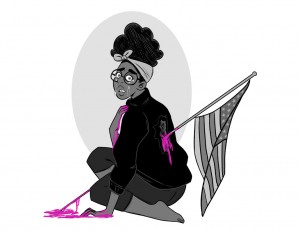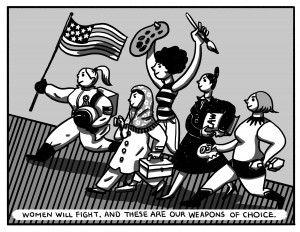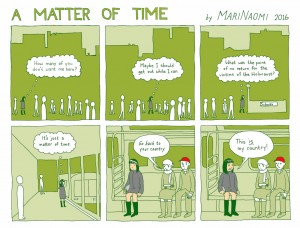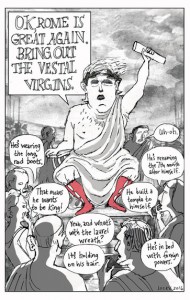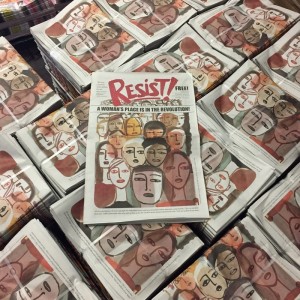 The November election and the events leading up to it left many with the desire to express themselves about the result. Among them were Francoise Mouly (The New Yorker) and Nadja Spiegelman (I’m Supposed to Protect You from All This), who have partnered with Gabe Fowler to produce RESIST!, a free 40-page protest newspaper featuring cartoons mostly by women-identified creators. The paper both embraces the free press and freedom of assembly protections of the First Amendment to reach people around the country.
The November election and the events leading up to it left many with the desire to express themselves about the result. Among them were Francoise Mouly (The New Yorker) and Nadja Spiegelman (I’m Supposed to Protect You from All This), who have partnered with Gabe Fowler to produce RESIST!, a free 40-page protest newspaper featuring cartoons mostly by women-identified creators. The paper both embraces the free press and freedom of assembly protections of the First Amendment to reach people around the country.
Resist! is set to be distributed January 20 – 22 at protests, bookstores, comic shops, and community spaces around the nation (you can help here). We managed to get a few moments with Mouly and Spiegelman to talk about Resist!, the tradition of protest publications, and free expression…
What can you tell me about the content of Resist!? You had more than a thousand submissions — how many were you able to fit in, and who are some of the people you are including, where are they coming from, and what are they saying?
Francoise Mouly: I think we have 120 plus. I think it’s over a hundred, or somewhere around a hundred women and also a section in the back of the “man cave,” and in between a page called “Gender Is Not Binary.” So all together, I think the total count is somewhere around 120 or so.
Of the actual number of submissions we got, I don’t know what proportion was men, what proportion was women. It started out with, when we were put the call out — it was the day before Thanksgiving — with more men than women and a lot of images people had in their files already…. And then it shifted to more women than men. Overwhelmingly more women than men, and overwhelmingly images that were done to show us for the publication on topic. We started asking for comics, so we started getting more and more comics… By the tail end of it, which was December 10th, we’re getting many comics by women on the topic of resisting the force of fascism.
Nadja Spiegelman: Some well-known cartoonists like Alison Bechdel and Lynda Barry and Emil Ferris, whose fantastic first book is coming out later this year. But in part what we’re really excited about is that we also have work by people who aren’t professional cartoonists. We have work by 13-year-old girls. We have work from people across the world… By using the democratic power of the internet, we were able to spread that open call so far and wide that we got all kinds of work we wouldn’t have gotten a chance to see otherwise and putting that together next to Alison Bechdel and Lynda Barry creates a really exciting, new feeling for a magazine.
Resist! revives the tradition of using comics for protest. What precedents inspired you in developing this project?
FM: Well, the first thing was being asked by Gabe Fowler [of Desert Island Bookstore] to guest edit a special issue of Smoke Signal, which is a tabloid printed on newsprint that he wanted to release at the time of the inauguration and the women’s march. When he got in touch with me specifically, like “I want a woman guest editor,” and because he asked right after the election and that was my feeling as well — since we’d just been robbed of our first woman president, there was a sense shared by so many — Gabe’s request seemed natural at the time… My friends were saying, “I’m going to Washington.” We didn’t know where or what. I mean, we knew it was the day after the inauguration, but there was some sense of wanting women’s voices heard.
NS: About historical precedent, and I think Francoise can talk very eloquently about historical precedents in France like L’Assiette au Beurre and Charlie Hebdo. One of the things is: there is a long historical precedent for political protest. But one thing that there isn’t, is enough contemporary parallels and enough space in American culture right now for political images as an act of resistance… We’re hoping to create more of that space.
FM: What was exciting was the opportunity of doing something printed on tabloid… You know, that’s what the underground comix were, and it’s a certain kind of very vital part of the underground press and the underground movement in the ‘60s. For me, it was Charlie Hebdo and Hara-Kiri Hebdo when I was in France, but a lot of [protest] in France was done with pamphlets glued on the wall. There are books of collections of pamphlets, but there is something exciting, inherently exciting, about the ephemeral nature of newsprint.
When I was on press last week, I couldn’t help taking photos of not just the tens of thousands of copies that have been coming off the press but also the bin in which the refuse, the crumpled sheets. There’s something exciting about it being both tangible and so throwaway, so giveaway. I mean, I am the one who 40 years ago, 30 years ago did the magazine Raw that was the antithesis of newsprint because it was giving comics its lettre de noblesse and putting them on good paper and something to be preserved, but that was what was needed at the time. What’s needed now is the immediacy of a free giveaway, a hand-staining newsprint rather than a coffee table book.
How does the First Amendment inform your point of view in developing Resist!? What is unique about the American approach to free expression that affected the way you developed the project?
FM: Well, we have one marvelous gift that was given to us which is that we’re not selling the paper, so we didn’t need to do grant applications. We didn’t need to ask permission. We didn’t need to fear that the sponsor would back away from us. All of the things that could — you know, censorship is one thing, but self-censorship is far more effective. And a lot of what silenced voices is the fear that they won’t meet the goal on Kickstarter or you know, that their patron will stop. So, by having responded to a call from someone like Gabe who will give us carte blanche, like he offered it without any kind of editorial oversight, we were able to put an image of a woman seen from the back holding an umbrella… protecting herself from a rain of penises, and an image of a nasty uterus, and a lot of sassy, probably-not-necessarily-general public images. Opinionated images. Quirky images. People who can’t draw.
NS: The only kinds of things that we did is at some point when we were doing the layout, Francoise was doing it, and I was like, “Ehh, maybe we shouldn’t put the image about sex workers RIGHT next to the image by the 13-year-old girl.” (laughs) But other than that —
FM: But they both had to be there.
NS: We did include both… We had no desire to limit the range of opinions and voices that were in our paper. We took as our mandate as editors to to make a distillation that would be as diverse as possible and include as many of the different kinds of voices we were hearing as possible. Even if it wasn’t things that we — We weren’t looking for things that we agreed with or that said what we already thought. We were looking for something that said as wide a range of different things as we could.
FM: Surprisingly nobody sent us anything that was in praise of Donald Trump.
NS: I got an image of somebody’s butt. We didn’t print it. (laughs)
In addition to exercising freedom of the press with this publication, you’re also using freedom of assembly as a way to distribute Resist!. Can you tell us a little bit more about those plans? Some of the obstacles, logistically and otherwise, that you’re facing and you’ve had to overcome?
FM: Logistically, one thing that’s been confusing is the fact that the woman’s march on Washington that provided both the date and physical starting point both in geography and in chronology, because it was going to be January 21st and it was going to be in Washington, has been somewhat complex in terms of whether people can rally behind it or not. But we kept our eye on the ball. We had the deadline — we wanted something printed in time to ship it to various places, including Washington. And that’s why we got it printed the first week in January. And that’s why we gave a deadline of December.
Now that we have it printed, we also welcome, the same way that it’s not just women, that we also have men, it’s not just Washington. We offered for people to be regional distributors. We had the 55,000 copies that were printed on pallets of 5,000, and each regional distributor is going to get a pallet of 5,000 copies in a range to distribute it in his local community on January 20, which is the inauguration, and 21 which is the march. So, everybody’s going to group their efforts and that means that if there’s a local sister march in that town — like for example Portland, Oregon, and Chicago and Dallas/Fort Worth and L.A. and Des Moines, Iowa — all of those people will get a pallet of 5,000 bundles of newsprint. And with that, they will either get volunteers to hand it out at the sister march when it happens on either of those two days and/or put it in bookstores, comic book shops, and so on to be handed out that day.
So, it is using old fashioned like printing presses and trucks and you know, just sheer physical get together that will make little cells out in the open and we publish a link so that people can sign up for those local distributions. Some people are coming to get them in New York to drive them to Philadelphia, for example. And fill up their vans. They will spread from one place to the other so that it will be a seemingly spontaneous eruption, at least a coordinated eruption, on the days of the 20th and 21st of getting that voice out.
How do you want people to be affected by Resist? What do you want readers to take away from it?
FM: We first did it to address our own need, and our need was to do something. Not just sit around being stunned and depressed — we wanted to do something affirmative. That’s when we succeeded, because the outpouring of responses, and even seeing all those images, I think that getting a copy — that’s obviously a reward that it gets into so many people’s hands.
We were also going to do a slideshow of all the submissions that we got. We want people to go “Ohhhh, wow!” There is an absolute force out there. We want them to be as aware as we are of the positive or the constructive force. It’s not a denunciation. It’s not an attack on Donald Trump. It’s a celebration of everything that we have in common, of not just women, but men also, and people for whom gender is fluid, as well as young, as well as old, as well as professional artists, as well as doctors and lawyers and grandmothers, as well as everyone who feels that they lost something on November 8th — they should be able to find something here that is at least as sustaining as what was taken away that day.
NS: One thing that was so moving when going through submissions was the sense, because we were sorting them by gender, we began to get such a sense of what a female voice is as distinct from a male voice and that female voice that you get when you look through the work as a whole — when you see that the empathy, funniness, vulgarity, the women drawing uteruses, but also drawing their mothers and daughters and grandmothers, and drawing women linked arm in arm and drawing how they felt the day after and drawing emotions and also their anger — that sense of the collective female voice is something that is so powerful… I think that — I hope that people just can hear that. That’s what I hope.
FM: You know, that’s a good point because as an art director, I never get a chance to do that. I don’t sort the submissions from people by their gender, and it’s actually not okay to just only solicit men or only solicit women. Even for the few occasions where I’ve done special issues, I prefer having a woman but I don’t discount the possibility that it can be men artists. But in this instance, we got to do what few art directors get to do which is to look at it in two separate categories.
And the fact that we got hundreds of images, it gave exactly what Nadja described — embodiment to the collective women’s voice that wasn’t commissioned by an art director but just rose from the ground… The fact that everything got posted on our website, where the point of entry was nil — they didn’t have to pay to enter their work, and we’ll be able to display that. I want people to be as impressed as we have been by the work, as well as the diversity and the depth and the richness and the self-confidence and the power of women when they feel that they are invited to speak aloud. They speak. It’s almost like being given a manifestation of what you get when you are hanging out with a bunch of friends and they’re not afraid of being listened to. This feels like it’s a really genuine expression that you seldom see in the press because it’s often edited and channeled.
NS: You very rarely have something that’s just, “Here are a lot of women artists, all next to each other, all together.”
FM: You usually have “see token woman artist.”
How do you anticipate continuing the work of Resist after the first issue? What’s next? And what would you like to see your fellow citizens do?
FM: We’ve been taking it one day at a time. And each step has somehow revealed the next step in a way that we didn’t know. When we put the call out, I really expected that I would get a response from the artists I knew and a modest response from people I didn’t know. I didn’t expect that it would be thousands of submissions, but once it happened, then obviously it colored the result. Once we had that, it was really imperative to distill it to something that’s less than ten percent of what we got but still be representative of the energy of what was given to us. Then, it was imperative to get it printed and not lose this overwhelming sense of excitement.
It’s really exciting, I have to say. Now the logistics, all of our efforts… is to make sure that we get it in as many cities as possible because again Washington was the starting point, but it’s not the end of the line. Now, we are actually beyond seven or eight, we are actually trying to do an activist network throughout the U.S.
—
You can help! Resist! will be distributed in Washington DC, New York City, Des Moines, Portland, Chicago, Dallas, Los Angeles, and Oakland / San Francisco. Volunteer online at http://www.resistsubmission.com/support.html
